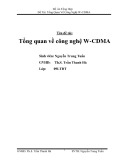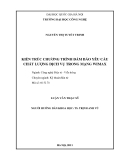
Kiến trúc evolution
-
Đồ Án Tổng Hợp.Đề Tài: Tổng Quan Về Công Nghệ W-CDMA..Tên đề tài:..Tổng quan về công nghệ W-CDMA.Sinh viên: Nguyễn Trung Tuấn.GVHD:..Th.S. Trần Thanh Hà..Lớp:..09LTĐT..GVHD: Th.S. Trần Thanh Hà..1..SVTH: Nguyễn Trung Tuấn...Đồ Án Tổng Hợp.Đề Tài: Tổng Quan Về Công Nghệ W-CDMA..LỜI NÓI ĐẦU.Nhu cầu trao đổi thông tin là nhu cầu thiết yếu trong xã hội hiện đại. Các hệ thống.thông tin di động với khản năng giúp con người trao đổi thông tin mọi lúc, mọi nơi đã.phát triển rất nhanh và đang trở thành không thể thiếu được trong xã hội thông tin ngày.nay.
 78p
78p  bautroibinhyen1
bautroibinhyen1
 02-11-2016
02-11-2016
 178
178
 11
11
 Download
Download
-
Trong những năm gần đây, mạng không dây ngày càng trở nên phổ biến với sự ra đời của hàng loạt những công nghệ khác nhau như Wi-Fi (802.1x), WiMax (802.16)...
 123p
123p  khanhhungno1
khanhhungno1
 24-03-2014
24-03-2014
 300
300
 127
127
 Download
Download
-
Công nghệ WiMAX là giải pháp tương thích tổng hợp cung cấp đa dịch vụ cùng lúc cho nhiều người dùng ở khoảng cách xa đồng thời cho phép các nhà khai thác dịch vụ hội tụ kỹ thuật trên nền mạng IP. Do đó mặc dù hiện nay công nghệ 3G đang phát triển với tốc độ dữ liệu không ngừng tăng việc nghiên cứu WiMAX vẫn có tính thời sự, nó vẫn là đích nhắm cho phát triển công nghệ thế hệ sau (Long Term Evolution - LTE) và đặc biệt nó là giải pháp kinh tế khi...
 77p
77p  daodungdkn117
daodungdkn117
 03-05-2013
03-05-2013
 126
126
 29
29
 Download
Download
-
Reference Architecture This chapter provides a consolidated view of the software-radio architecture models developed throughout the text for convenient reference. This consists of a radio platform view (Figure 16-1) and a software components view
 2p
2p  tienvovan
tienvovan
 11-09-2010
11-09-2010
 98
98
 9
9
 Download
Download
-
This chapter develops illustrative applications, including the design of a contemporary SDR infrastructure product, the disaster-relief system. I. THE DESIGN PROCESS The implementation of SDR applications can be structured into an SDR design process. This process begins with the definition of a concept of operations (CONOPS), in which functions of the product are identified. The next stage, system definition, includes rapid prototyping and benchmarking. The third stage, system development, includes the implementation of hardware-software components. ...
 11p
11p  tienvovan
tienvovan
 11-09-2010
11-09-2010
 87
87
 8
8
 Download
Download
-
Smart Antennas Smart antennas are an important application of SDR technology [381]. An in-depth treatment is beyond the scope of this chapter. The objective is to introduce the topic to identify the implications of smart antennas for softwareradio architecture. The smart antenna is a logical extension of antenna diversity described above [382].
 15p
15p  tienvovan
tienvovan
 11-09-2010
11-09-2010
 98
98
 10
10
 Download
Download
-
Segment Design Tradeoffs I. OVERVIEW The six steps in the systems-level design process associated with the software radio are illustrated in Figure 6-1. The tradeoffs proceed from front end to back end. The choice of antennas (step 1 in the figure) determines the number and bandwidth of RF channels (step 2). This, in turn, constrains the numbers and bandwidths of ADCs (step 3). Some waveforms may require dedicated ASICs (e.g., W-CDMA despreaders) in front of the ADCs. Additional parallel IF processing and ADC paths may be necessary to support multiple-service bands simultaneously....
 8p
8p  tienvovan
tienvovan
 11-09-2010
11-09-2010
 104
104
 9
9
 Download
Download

















